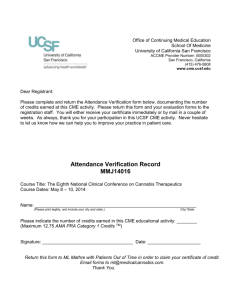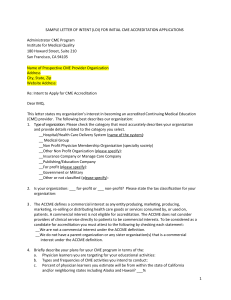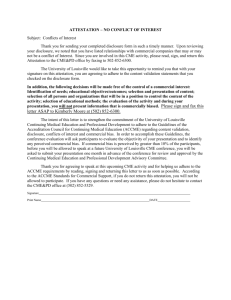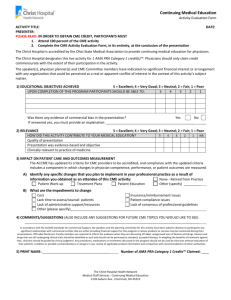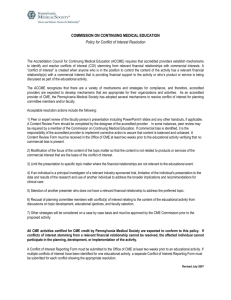Guidelines and Instructions for Completing/Reviewing the CME Application
advertisement
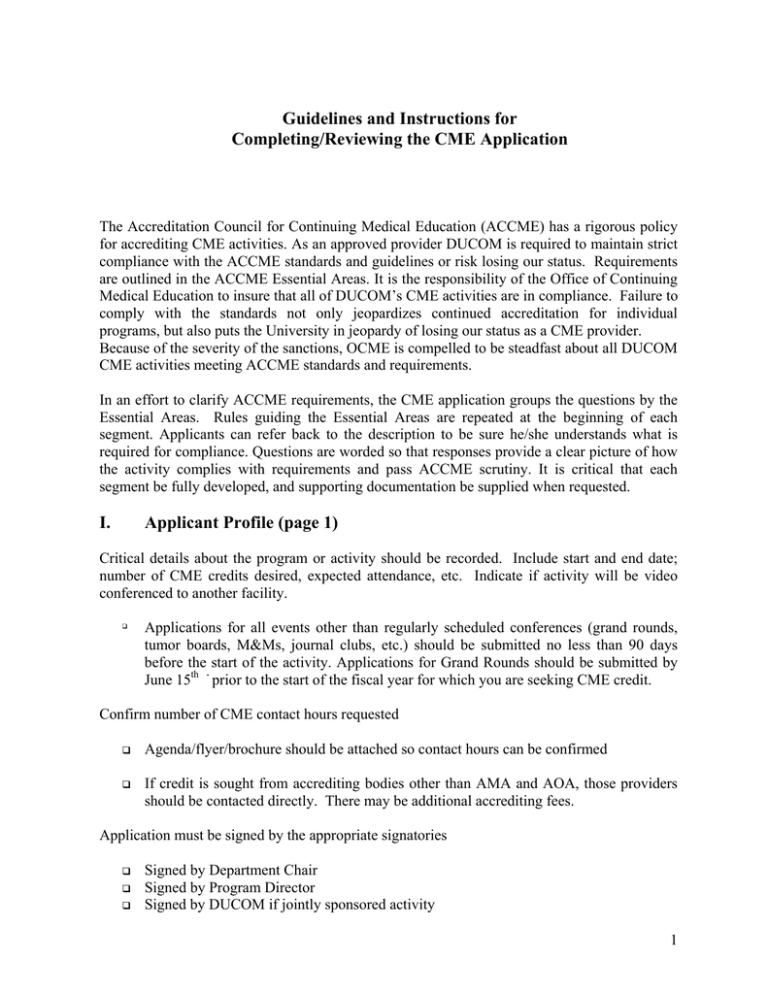
Guidelines and Instructions for Completing/Reviewing the CME Application The Accreditation Council for Continuing Medical Education (ACCME) has a rigorous policy for accrediting CME activities. As an approved provider DUCOM is required to maintain strict compliance with the ACCME standards and guidelines or risk losing our status. Requirements are outlined in the ACCME Essential Areas. It is the responsibility of the Office of Continuing Medical Education to insure that all of DUCOM’s CME activities are in compliance. Failure to comply with the standards not only jeopardizes continued accreditation for individual programs, but also puts the University in jeopardy of losing our status as a CME provider. Because of the severity of the sanctions, OCME is compelled to be steadfast about all DUCOM CME activities meeting ACCME standards and requirements. In an effort to clarify ACCME requirements, the CME application groups the questions by the Essential Areas. Rules guiding the Essential Areas are repeated at the beginning of each segment. Applicants can refer back to the description to be sure he/she understands what is required for compliance. Questions are worded so that responses provide a clear picture of how the activity complies with requirements and pass ACCME scrutiny. It is critical that each segment be fully developed, and supporting documentation be supplied when requested. I. Applicant Profile (page 1) Critical details about the program or activity should be recorded. Include start and end date; number of CME credits desired, expected attendance, etc. Indicate if activity will be video conferenced to another facility. Applications for all events other than regularly scheduled conferences (grand rounds, tumor boards, M&Ms, journal clubs, etc.) should be submitted no less than 90 days before the start of the activity. Applications for Grand Rounds should be submitted by June 15th - prior to the start of the fiscal year for which you are seeking CME credit. Confirm number of CME contact hours requested Agenda/flyer/brochure should be attached so contact hours can be confirmed If credit is sought from accrediting bodies other than AMA and AOA, those providers should be contacted directly. There may be additional accrediting fees. Application must be signed by the appropriate signatories Signed by Department Chair Signed by Program Director Signed by DUCOM if jointly sponsored activity 1 II. Essential Area 1 (page 2) The CME activity should be complimentary to the University’s mission. Target audiences should be clearly identified and appropriate to our mission Physicians PAs RNs Social workers Other health care professionals The type of activity and teaching methodology must be stated clearly Didactic Case demonstrations Problem based learning lecture Web based Laboratory Preceptorship III. Essential Area 2 (pages 2 to 4) Planning Committee Include list of all planning committee members. Attach to the CME application a completed Disclosure of Relationships and Declaration Form for each committee member. The application will not be processed if all planning committee Disclosures are not attached. Planning Process The planning process of the activity is an important factor. It is necessary to show 1) there was an established process for deciding what course(s) will be offered and 2) the course(s) offered actually resulted from a formalized needs assessment process. Program Directors must document the planning process, show how the educational needs were determined, identify the learning objectives and link the objectives to the expected performance outcome. Does applicant show clear documented link between the identified educational needs and the CME activity Does applicant list sources of needs assessment data? Is documentation of the planning process and needs assessment method(s) attached 2 Educational Needs Programs must be designed to meet specific educational objectives for a target audience It is recommended that you use two or three strategies for determining educational needs. The method of determining educational needs must be specified and documented. The method for determining needs should be fully detailed. Tools used to determine needs must be supported by documentation. Documentation can include planning committee meeting minutes, evaluation summaries from prior years, focus groups minutes, quality assurance data, expert opinion, journal articles, notes from group discussions, etc. If the above documentation is not available, there should be a statement from the Program Director explaining the needs assessment process and those who contributed. Learning Objectives Learning objectives “define a concrete, observable, measurable behavior you expect to exhibit.” Objectives provide the road map for operationalzing and measuring educational goals. Objectives are action-oriented words that identify the steps required to help the learner achieve the intended goal of the educational experience. Are objectives measurable Do objectives answer the question “after participating in this activity attendees will be able to…?” Do objectives logically lead to the final outcome The brochure and/or flyer must list the target audience, learning objectives and act as the required documentation that objectives were communicated to the audience prior to the activity. Attach to the application either a draft of the current brochure/flyer or a copy the prior year brochure/flyer along with the current program agenda. The new brochure/flyer must be approved by OCME prior to printing. Evaluations CME activities must be evaluated. Evaluations provide critical feedback for improving the quality of CME activities and planning future offerings. Evaluations are also important tools for determining if compliance requirements were met, accessing the educational impact and measuring changes in practice habits and attitudes. Does the evaluation inquire about a perceived change in physician’s behavior/attitude or a change in patient outcome? Is sample evaluation from attached? Were the speaker’s relationships and commercial support disclosed to the audience? Was the presentation free of commercial bias and evidence based? 3 IV. Essential Area 3 (pages 4 to 6) The Provider must comply with all ACCME guidelines and policies. The Provider must also communicate the requirements to everyone involved in the activity including the planning committee, the speakers, the audience and commercial supporters. The provider must inform commercial supporters of the compliance requirements listed in the ACCME Commercial Standards for Support. The provider must take responsibility for informing the sponsor of their responsibilities; that funding is in the form of an unrestricted educational grant; that commercial grants are preceded by a Letter of Agreement signed by the company and Drexel College of Medicine (the Provider); and commercial support is acknowledged in all written materials and announced to the audience. Speakers must complete and submit the Disclosure of Relationships and Declaration Form at least eight weeks prior to the activity. On the Disclosure the speaker must identify relationship he/she or his/her domestic partner has where compensation was received from pharmaceutical or medical device companies within the past twelve months. This includes stock ownership. consultancies, speaker’s bureau and/or clinical trials. If there is a potential conflict of interest, this conflict must be resolved prior to the activity. Disclosure of relationships (or lack of relationships) and the method of resolution must be announced to the audience prior to the beginning of a CME activity. V. Budget (page 7) Budget should reflect the following: $300 application fee (directly sponsored Grand Rounds are excluded) Correct accreditation fee (if applicable). Fee for certificates and/or transcripts (if applicable). Total expenses should be less than or equal to income If pursuing commercial support to cover honoraria, travel or marketing expenses the source(s) of support must be listed in the budget. Identify the names of and amount anticipated from commercial supporters (actual figures must be reported in the financial report at end of activity) Must show how excess funds will be used Must show the source of additional funding if expenses exceed anticipated revenue 4


